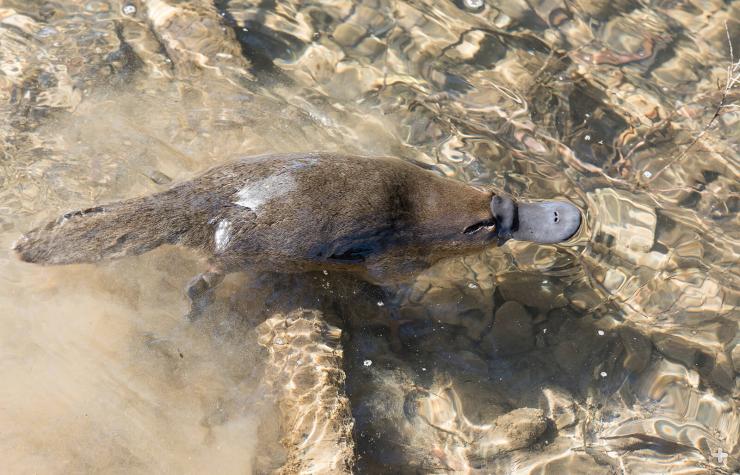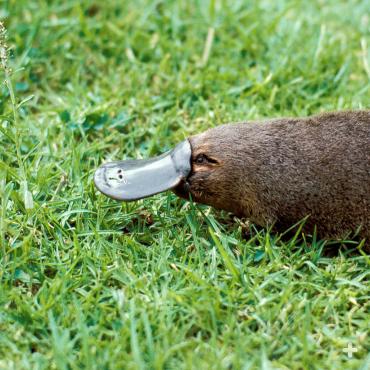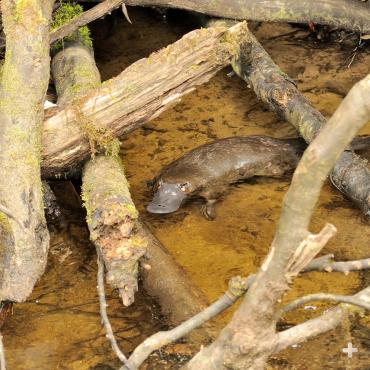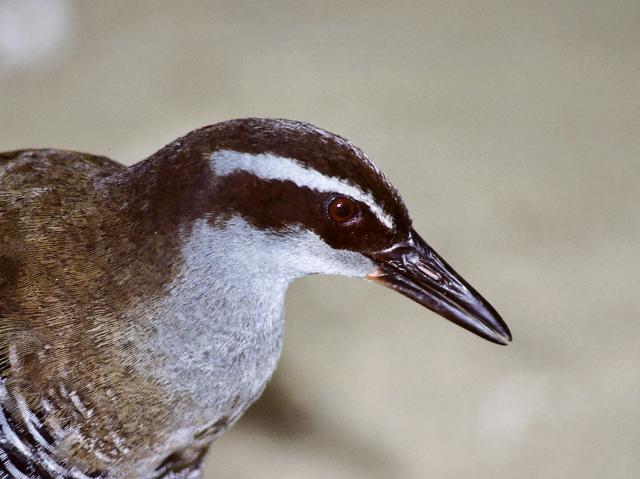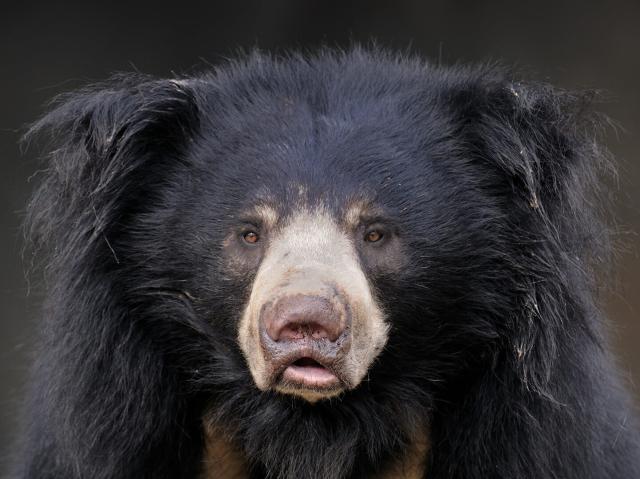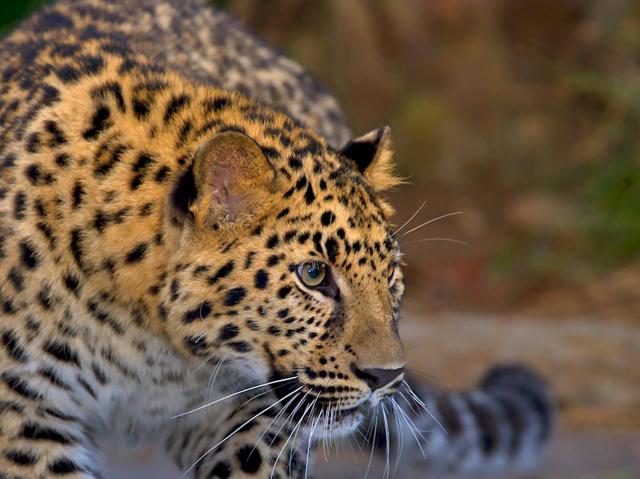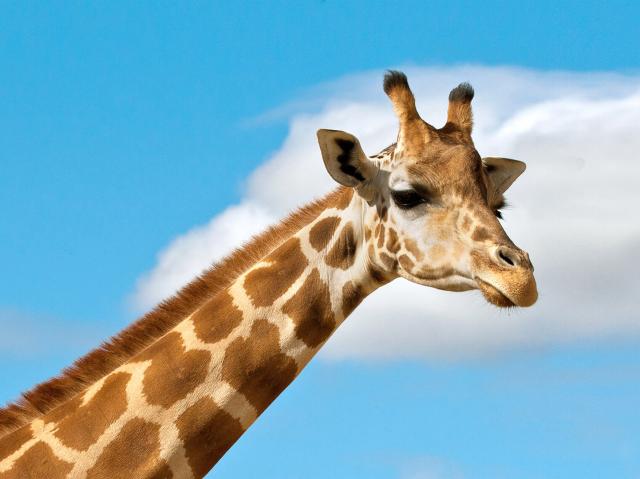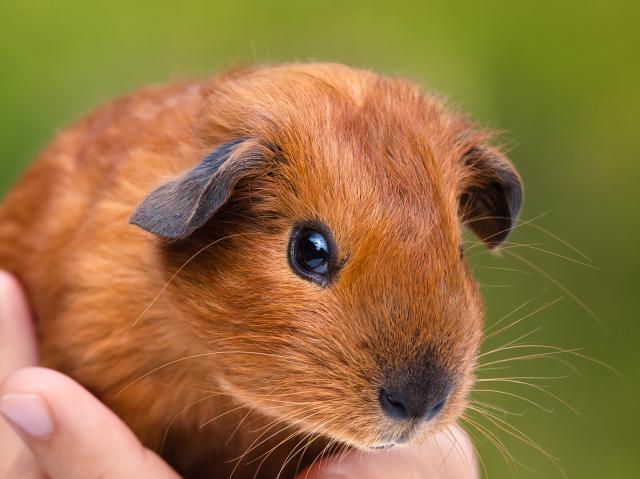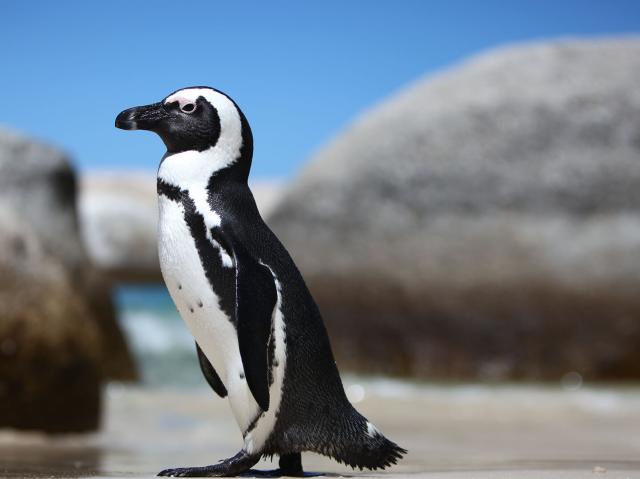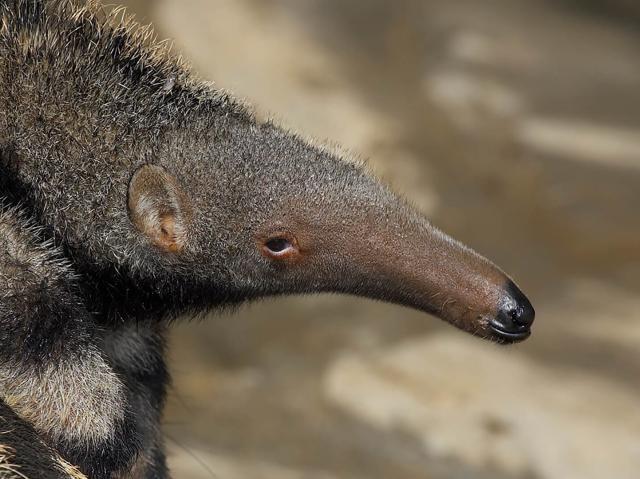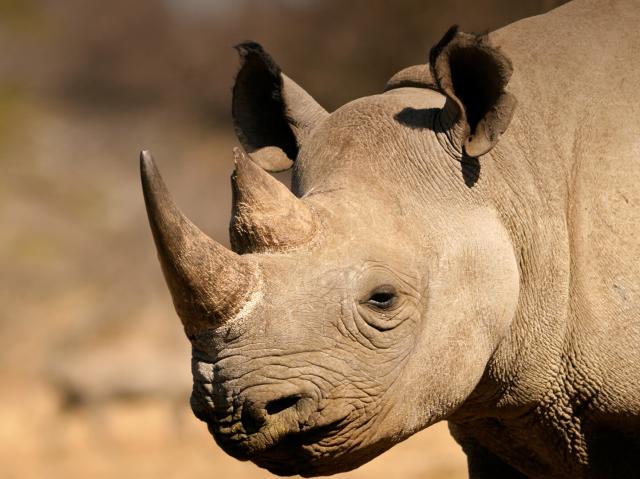
Platypus

- Class: Mammalia
- Order: Monotremata
- Family: Ornithorhynchidae
- Genus: Ornithorhynchus
- Species: anatinus

ABOUT
Among Australia’s most iconic wildlife, this semi-aquatic, egg-laying species is also one of few venomous mammals. At a glance, it appears to resemble a combination of many other species, with a paddle-shaped tail like an otter, a sleek body covered in dense, chestnut-colored fur like a mole, a wide, flat duck-like bill attached in front of its little round eyes, and big webbed feet like a pelican.
All these characteristics come in handy for its freshwater lifestyle—that wide bill is laden with thousands of receptors that help a platypus navigate the murky depths of streams and lakes and detect tiny movements of potential food like shellfish or insects.
While platypuses only live in eastern and southern Australia, they weather many climate extremes (and fresh water sources) from toasty plateaus and rainforests, to the chilly mountainous regions of Tasmania and the Australian Alps. Their dense fur makes fine insulation, both in the water and out.
Platypus fur is waterproof and traps an insulating layer of air to keep its body temperature stable, even in cold water. Long guard hairs protect the dense fur underneath, which stays dry even after a platypus has been in the water for hours. Mostly brown on its body, there’s a flash of white fur beneath its eyes, and its belly is lighter in color, too.
Those big, webbed feet help propel platypuses through the water, and claws make digging burrows a breeze. While lumbering somewhat awkwardly on land to protect the webbing on its feet, they are sleek missiles in the water. Its plump tail serves as a stabilizer during swimming and stores extra fat for energy. Its rear feet serve as rudders and brakes.
Its signature “duck bill” is actually soft and pliable, not hard like a duck’s bill at all. It is dark colored, nearly black in contrast to its chocolate-colored coat. This unique snout is laden with “pushrods” that respond to stimuli like touch, pressure, sound waves, and motion. Additionally, about 40,000 electroreceptors help them find the direction and distance of prey (its eyes and ears are closed while it’s underwater) by detecting electrical impulses generated by living creatures. Moving its head back and forth, it can find prey nearby and swiftly move in for the kill.
Platypuses stow their prey in cheek pouches, and then swim to the surface to eat. They (and their monotreme relatives called echidnas) don’t have teeth, but instead grind their food between mouth pads made of keratin. These pads are replaced continuously throughout their lifetime. Interestingly, freshly hatched platypuses have molar-like “milk teeth," but these are shed around the time they leave the nesting burrow.
Of course, its major claim to fame is being an egg-laying mammal, or monotreme. While most other mammals give birth to live young, platypuses (along with echidnas) lay eggs, incubate them, and nurse their young.
Other interesting characteristics include extra bones in the shoulder girdle, which is absent in other mammals. On land, platypuses have a reptilian gait because their legs are on the sides of their body, rather than underneath. The white spots on their fur under their eyes make it look like their eyes are open underwater, but they’re not.
There is considerable variation in size among platypus populations. Generally, body size increases with latitude. So, platypuses are smaller in northern regions, and larger in southern regions. For instance, a large male platypus in Tasmania can weigh three times as much as an average male in a northern population. Overall, males are larger than females and can measure 16 percent longer and 40 percent heavier than them.
HABITAT AND DIET
Platypuses live almost exclusively in fresh bodies of water like streams, lakes, pools, and ponds. There, they find most of their diet: small, aquatic bottom-dwelling aquatic invertebrates. When not foraging, they occupy nesting burrows in earth banks. They rarely walk along the mainland in Australia, though, preferring to stick to the water. Those in southern Tasmania venture out more often. Platypuses may also live in artificial water sources like water storage lakes, weir pools, ponds, and farm dams. They occasionally dip into brackish areas of estuaries, but mostly stick with freshwater areas.
Adult male platypuses have larger home ranges than females—as long as 9.3 miles (15 kilometers)! A male may travel over 6 miles (10 kilometers) in a single night’s jaunt. Females tend to hunt closer to home, and her turf is usually less than 2.8 miles (4.5 kilometers) long.
While they may make repeated, short dives of 30 to 60 seconds or so, platypuses can stay underwater for up to 2 minutes. Dive time and depth is reliant on air in its lungs—they usually dive less than 16 feet (5 meters), though they occasionally take deeper dives to about 26 feet (8 meters). They come to the surface to recover for 10 to 20 seconds between dives.
These underwater forays enable platypuses to feed on insect larvae, freshwater shrimp, freshwater crayfish called "yabbies" (which it nuzzles out of the riverbed with its snout or catches while swimming), and worms. They use cheek pouches to stow bounty until reaching the surface, where they can eat. Each day, a platypus needs to eat about 20 percent of its body weight, which requires about 12 hours of looking for food.
Lacking teeth, a platypus must scoop up bits of gravel with its food to help grind its meal. They swallow soft parts of their prey and spit out the chitinous exoskeletons (like the shells of crayfish and insects).
Due to a somewhat limited capacity for holding their breath, platypuses forage in more shallow lakes and bodies of water, between 3 and 16 feet (1 and 5 meters) deep.
Male and female platypuses dig simple burrows along rivers and streams outside the breeding season. They can also make their home under rock ledges, roots, and debris, where they rest throughout the day. However, pregnant females dig a deeper, more elaborate nesting burrow, with multiple chambers and entrances, called a nursery burrow. When a female leaves her young behind to forage, she makes a soft covering of soil and debris to plug the opening. Resting burrows are used by males and nonbreeding females.
The average body temperature of a platypus is about 90 degrees Fahrenheit (32 degrees Celsius), while most placental mammals run about 99 degrees Fahrenheit (37 degrees Celsius). They can maintain this temperature even when foraging for hours in water below 39 degrees Fahrenheit (4 degrees Celsius). Brrrr!
FAMILY LIFE
Platypuses are naturally active at night and dusk, and occasionally active by day. They emerge from their burrows in late afternoon to forage for food. By early morning, they re-enter their burrows. One scientist found that platypuses in the southeastern Australian state of Victoria spent 11 to 17 hours holed up in their burrows. Others have found that platypuses can hunt for 10 to 12 hours at a time. Their high-calorie diet of crustaceans enables them to sleep soundly for up to 14 hours a day! A platypus spends nearly 60 percent of its daily sleep in deep, brain-active REM sleep (in contrast, people spend about 25 percent of their slumber in that rich, REM state).
Pregnant females spend time building a cozy nest, nursing and nurturing their young, and foraging for food. While platypuses are not considered hibernators, they may be inactive for extended periods of time.
For a platypus, leaving the burrow is a high-risk proposition, even at night. When drought or altering of waterways occurs, platypuses must travel on land, making them more vulnerable to predation. Aerial predators like owls, eagles, and hawks may prey upon them. Native threats like dingoes, Tasmanian devils, monitor lizards, snakes, and water rats also await. Invasive feral and unleashed dogs, cats, and foxes also take them. Dwindling platypus populations in northern Australia may be a result of heavy predation by crocodiles.
Male platypuses have spurs on their rear ankles, connected to a venom gland located over their thighs. If the spur pierces skin, it can release enough venom to kill a medium-sized dog. (It is not fatal to people, but is excruciating, and causes swelling.) The venom is more plentiful during breeding season, leading scientists to believe that it's used to defend mates and resources from rival males.
As air-breathing, aquatic mammals, platypuses can quickly drown after getting entangled in discarded litter, fishing line, and mesh netting. “Opera house” nets that people set to catch crayfish and yabbies can inadvertently harm wildlife like platypuses, turtles, and water rats, that cannot escape. These underwater traps (roughly shaped like the Sydney Opera House, hence the name) are often set during summer months, when female platypuses may be pregnant, which exacerbates the impact on platypus populations. Even common items like rubber bands, plastic rings, or hair ties can cause harm when caught on the legs or neck of a swimming platypus.
Platypuses are largely solitary, so a vast vocal repertoire is not necessary. They growl when disturbed, and a range of other vocalizations have been noted.
Scent glands on both sides of their neck produce a musky scent during the breeding season. They rub against logs and rocks near the water to mark objects. When swimming, a platypus will make a big splash when alarmed as it slips beneath the surface, likely to give other platypuses a heads up. Usually, they are nearly silent when diving.
Males compete for breeding opportunities (hence the venomous spur), while females typically mate with a single male. Once she has settled on a male, aquatic courtship ensues, with the pair diving and swimming past each other, then grasping and rolling together.
Pregnant platypuses seek shelter in a burrow chamber dug into a riverbank to lay 1 to 3 eggs. This elaborate burrow is much deeper and blocked at intervals with plugs, which may protect her eggs from predators or rising waters, or regulate humidity and temperature in the burrow. She lines this nesting chamber with wet leaves, twigs, and vegetation, which she carries into her burrow between her hind feet and her tail.
Safely sealed inside, she keeps her eggs between her rump and her tail to keep them warm, only leaving the burrow to defecate and wet her fur. Typically, her eggs are about 0.7 inches (1.7 centimeters) in diameter and rounder than bird eggs. The shell is soft and pliant.
After about 10 days, the hairless, bean-sized babies hatch and begin to suckle for the next 3 or 4 months. The mother does not have nipples, but rather special patches of skin on the abdomen that exude milk for her babies to slurp up. By the time they are weaned and leave the nest, baby platypuses have fur and can swim on their own.
AT THE ZOO
The San Diego Zoo Safari Park is currently the only zoo outside Australia to care for platypuses. When two platypuses—a male named Birrarung and a female named Eve—arrived in San Diego in October 2019, it was the first time in more than 50 years that platypuses were cared for outside of Australia.
It's our honor to care for these incredible monotremes, and to communicate the importance of fresh water ecosystems for both people and wildlife. Freshwater resources and habitats are being affected by pollution and climate change. However, we can protect wildlife together through water conservation measures and practices that help slow climate change.
Guests can experience platypuses in Walkabout Australia's Nelson A. Millsberg Platypus Habitat, which includes three pools, naturalistic riverbanks, extensive tunnels, and nesting areas. There, you may see platypuses exploring every inch of their surroundings, playing in the waterfalls and hunting for crayfish. Because platypuses are most active during dusk and nighttime hours, the lighting cycle in their habitat mimics evening light during the day and daylight at night.
CONSERVATION
Fresh water is a precious resource. As development booms and populations of people disrupt aquatic ecosystems, it can impact platypus populations. San Diego Zoo Wildlife Alliance is proud to support a cutting-edge conservation effort in southeastern Australia that benefits endemic wildlife, including platypuses. A collaborative team is using a new technology called environmental DNA (eDNA) to map the distribution of and threats to five kinds of fish and platypuses. The goal is to safeguard populations in at least three natural catchment (or watershed) areas.
As living things shed their DNA through skin, hair, scales, feces, and eggs, water samples collected and filtered through a special unit that strains out cells and analyzes them will reveal the wildlife that are present. San Diego Zoo Wildlife Alliance is honored to support innovative fieldwork to preserve endemic wildlife, including platypuses.
By joining San Diego Zoo Wildlife Alliance as an ally for wildlife, you help save species worldwide.
SIZE
Length from tip of bill to tip of tail: males 16 to 25 inches (40 to 63 centimeters); females 15 to 22 inches (37 to 55 centimeters)
Weight: males: 1.8 to 6.6 pounds (0.8 to 3 kilograms); females: 1.3 to 3.7 pounds (0.6 to 1.7 kilograms)
Length at hatch: about 1 inch (2.5 centimeters)
Life Facts
Life span: 12 to 15 years on average
Gestation: approximately 21 days
Incubation: approximately 10 days
Number of young at hatch: 1 to 3 eggs per breeding season; usually 2 eggs
Age of weaning: 3 to 4 months old
Fun Facts
The word “platypus” originates from a Greek word meaning “flat foot.” The correct plural ending is “es”—making “platypuses” preferred over “platypi.”
Platypuses and echidnas are the only living mammals that lay eggs. They are called monotremes.
Females don’t nurse their young with nipples, rather they exude milk through skin patches.
Adult male platypuses have venomous spurs, an unusual characteristic among mammals, used to defend mates and territory from rival males.
Females have two ovaries, but only the left one is functional, similar to many birds and some reptiles.


